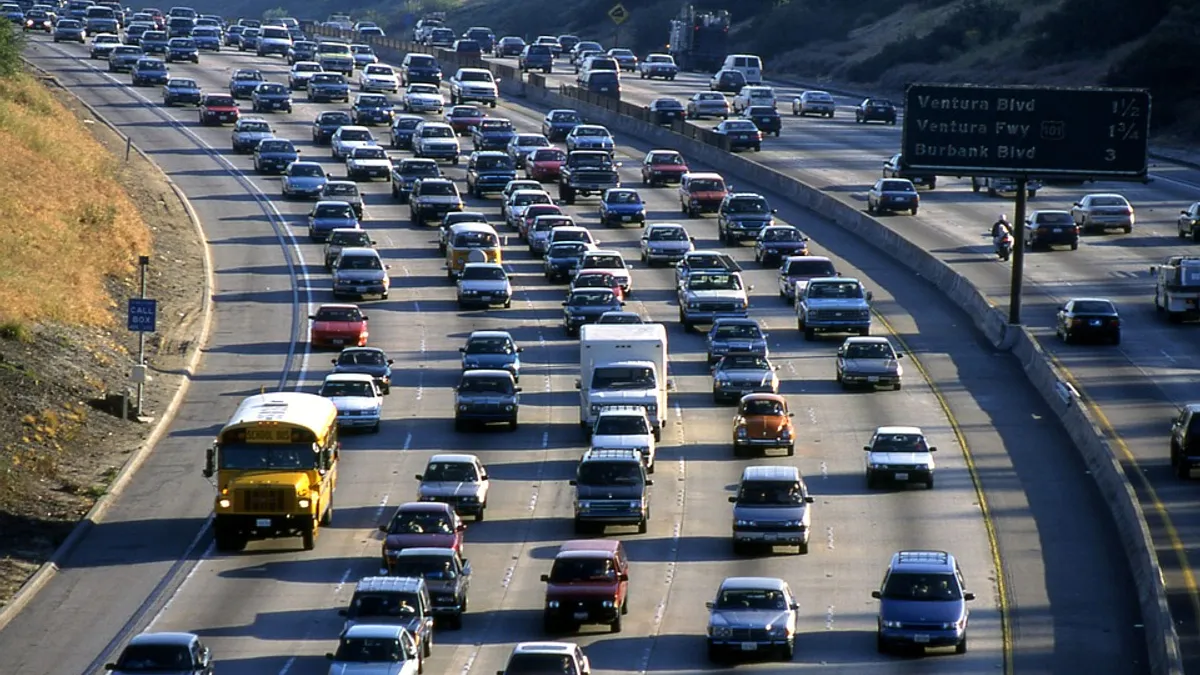Dive Brief:
- California Gov. Gavin Newsom on Wednesday issued an executive order adopting a goal for the sales of all new passenger vehicles in the state to be zero-emission by 2035, taking aim at the roughly 50% share of the state’s greenhouse gas emissions that come from the transportation sector.
- The order instructs the California Air Resources Board (CARB) to craft regulations mandating that goal, which will reduce more than 35% of greenhouse gas emissions from cars statewide, according to Newsom's administration. It also tasks the agency with ensuring that medium- and heavy-duty vehicles are 100% zero emission by 2045 "everywhere feasible."
- There's a long way to go before Newsom's order leads to a potential mandate, if any, said Morten Lund, a partner at Stoel Rives. But if it does, "this will change the nature of load. And it's important that the grid planners know this, so it's good they have as much warning as possible."
Dive Insight:
Newsom's executive order includes a series of instructions for state agencies, including requiring the Governor's Office of Business and Economic Development to work with CARB, the California Energy Commission and the California Public Utilities Commission, along with other entities, to create a zero-emissions vehicle market development strategy by Jan. 31, 2021. That strategy will then be updated every three years.
The move comes against the backdrop of a series of destructive wildfires that have burned more than 3 million acres of California this year. Earlier this month, Newsom said he would "fast track" the state's climate change goals, saying he had asked agency officials to take a closer look at current strategies "and accelerate all of them across the board."
Staying on track to reach 100% zero-emission passenger vehicle sales in 2035 would lead to a 9% increase in electricity demand by 2030, according to Amanda Myers, policy analyst with Energy Innovation. In any highly electrified future, energy will come from electricity rather than fossil fuels, which is something utilities will be taking into account.
"They have planning processes in place, so I don't think it's necessarily creating any new process — it's just these kinds of inputs will change," Myers said.
At the same time, EVs are flexible load, which could open up other opportunities for supporting the grid.
"We already have EVs serving as a demand response resource for CAISO as an aggregated resource, but we're just scratching the surface there of the potential," Matt Stanberry, managing director at Advanced Energy Economy said. "And there are many other grid services that EVs can provide — and actually, you need to look no further than the [Federal Energy Regulatory Commission] order that came out just within the last few days on DER access to the wholesale markets."
For instance, encouraging EV charging during times of peak solar — times when the state has excess solar and low demand — could help capitalize on what's essentially costless power, saving money on fueling vehicles, Stanberry said. And the order could also end up speeding up a lot of processes in the state, like pushing the CPUC to move faster on vehicle electrification work.
"We're going to have to do more work on rate design faster, we're going to need to do more work on managed charging programs," as well as move forward vehicle-to-grid integration from workshops and papers to actual implementation, Stanberry said.
It's reasonable to expect that more EVs on the road will increase load, Lund said. But "frankly, not in an earth-shaking way, just because we're already on our way to a 100% grid renewable requirement anyway."
And while it will change the nature of the load, Lund said, "I strongly suspect that the grid planners of the world are already looking to an all-electric vehicle future."
At the same time, the order could have other implications for the power sector — for instance, California has been talking about vehicle-to-grid storage for a decade, according to Lund, and while the technology has crept along, it's also been held back by the lack of volume and critical mass.
But if you have millions of electric vehicles on the road, "all of a sudden it suddenly makes sense to think of the batteries in the vehicles as part of a solution to the grid," Lund added.
Another impact of having more EVs on the road would be spurring on the solar industry — specifically, distributed, residential-level solar, Lund said. Solar makes a lot of sense for people who have EVs, in part because of the tiered pricing structure attached to it.
"It's no accident Tesla makes cars and solar panels," Lund said. "We've been slowly moving from a centralized utility model to a distributed utility model for the last 25 years, and it's been accelerated most recently by residential solar with residential storage — and electric cars, I think, are a huge part of accelerating that progress."















